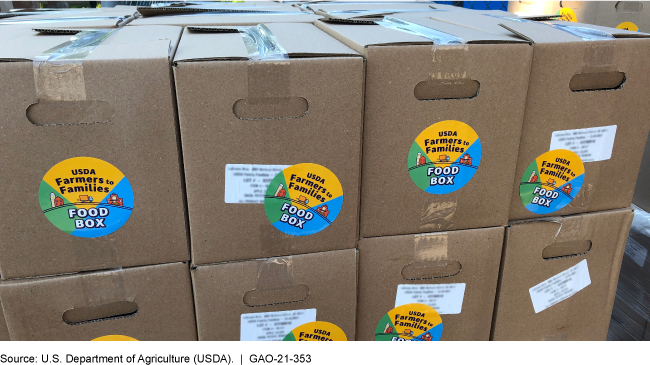USDA Food Box Program: Key Information and Opportunities to Better Assess Performance
Fast Facts
USDA's Food Box Program was a response to pandemic-related disruptions in the food supply chain. The program paid contractors to buy food from producers and deliver it to organizations like food banks—aiming to
- Provide food to the needy
- Maintain food distribution jobs
- Create alternative outlets for food producers after they lost customers (e.g., restaurants)
USDA's data shows that more than 176 million boxes were delivered to those in need. One lesson USDA learned during the program was that it should have been collecting data to assess the other 2 program goals. We recommended collecting data to better assess similar food programs.

Highlights
What GAO Found
Through contractors, the U.S. Department of Agriculture's (USDA) Farmers to Families Food Box Program purchased fresh fruits and vegetables, dairy, and meat products from producers and delivered them to recipient organizations, such as food banks. USDA's goals for the program included providing food to those in need, helping contractors retain jobs, and supporting producers. USDA collected large amounts of data and analyzed various data on deliveries to recipient organizations—that is, total number of food boxes delivered to each state and per million people in each state—and determined that the program met its goal of providing food to those in need. GAO further analyzed USDA's data and found that 243 contractors delivered more than 176 million food boxes to recipient organizations across the U.S. and territories by the end of the program (see figure). GAO's analysis also found that food boxes were delivered to nearly 78 percent of all U.S. counties, including to more than 89 percent of counties where at least 20 percent of the population lives in poverty.
Number of Food Boxes Contractors Delivered to Recipient Organizations for the Food Box Program

USDA could not analyze the program's performance in meeting its other two goals: (1) helping contractors (i.e., distributors of goods) retain jobs and (2) helping food producers faced with declining demand—because USDA did not systematically collect the necessary data. For example, USDA did not collect data on (1) the number of jobs contractors might have lost but ultimately retained as a result of participating in the program and (2) the number, category, and size of participating producers or whether the pandemic had reduced demand for or sales of the type of product the producer provided for the program.
USDA officials acknowledged that a key lesson learned during the implementation of the Food Box Program was the need to collect and analyze such data but that the department did not have time to do so. Federal guidance expresses the importance of balancing speed with transparency, and states that federal managers should use data and evidence to achieve program goals. By applying this lesson learned to current and future emergency food assistance programs, USDA would have greater assurance that it can assess program effectiveness even when it must move quickly in implementing a program.
Why GAO Did This Study
The COVID-19 pandemic caused disruptions in the U.S. food supply chain and contributed to a national hunger crisis. In response, USDA implemented the Food Box Program in May 2020. USDA directed a total of $6 billion in congressional appropriations to the program, which lasted 1 year. The program included organizations such as food banks, which received food boxes; contractors that purchased and delivered the food; and food producers, such as farmers and ranchers.
The CARES Act contained a provision for GAO to conduct monitoring and oversight of the use of funds related to the COVID-19 pandemic. This report examines the extent to which USDA collected and analyzed data on participants in the program, including data necessary to assess performance in meeting program goals.
GAO analyzed information from USDA's website, database, and departmental guidance. GAO also compared USDA's efforts to collect and analyze data on the program against federal guidance, USDA's strategic plan, and documents that include lessons learned. GAO also interviewed USDA officials.
Recommendations
GAO recommends that USDA apply the lesson learned from the Food Box Program regarding collecting and analyzing data to assess program goals to current and future emergency food assistance programs. USDA agreed with the recommendation.
Recommendations for Executive Action
| Agency Affected | Recommendation | Status |
|---|---|---|
| Department of Agriculture | The Secretary of Agriculture should take steps to apply the lesson learned from the Food Box Program regarding collecting and analyzing data to assess program goals to current and future emergency food assistance programs. (Recommendation 1) |
As of April 2022, according to USDA officials, if the Agricultural Marketing Service is called upon to support another major emergency food purchase program, it will develop a plan to collect and analyze available data to assess program goals and results utilizing the technology available to the agency. USDA officials provided documentation to show that the agency informed key staff through a memorandum of its expectation that in the case that it should implement another emergency food purchase program it would apply this lesson learned from the Farmers to Families Food Box Program.
|
